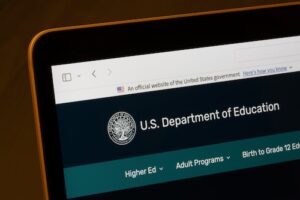Key points:
- Colleges and universities must form stronger partnerships to fill the void left by federal oversight
- Higher education in flux: Students at the heart of change
- Reshaping higher education: The impact of proposed federal changes on institutions
- For more news on the Department of Education, visit eCN’s Campus Leadership hub
The shock is palpable. While discussions about reducing federal oversight in education have circulated for years, few in the academic community believed it would happen. Yet here we are. The Trump administration is planning on releasing an executive order to systematically dismantle the U.S. Department of Education, setting in motion a plan to shift its responsibilities--or eliminate them altogether.
More News from eCampus News
Data shows growing GenAI adoption in higher ed
Nearly half of HED instructors (45 percent) have positive perceptions about GenAI, despite concerns and perceived risks in its adoption, according to updated data from Cengage Group’s “AI in Education” research series.
College claim to deliver value, but struggle to track its delivery
Although nearly 75 percent of colleges and universities believe their value proposition is clear, less than 10 percent of schools say they have built a reliable tracking process to ensure their perceived value is actually delivered.
Academic freedom under siege: A Ph.D. student’s reflections
As a doctoral student currently engaged in scholarly research within a U.S. higher education institution, I find myself increasingly alarmed by recent developments that suggest an erosion of academic freedom and civil liberties.
4 student mindsets that rationalize cheating
Understanding how students justify cheating can help faculty address the root causes. This article covers common student mindsets that rationalize cheating and offers practical ways to address them before they grow into a cheating culture.
The hidden cost of legacy systems in higher ed
As universities shape the future and prepare the next generation of leaders and innovators, it’s more important than ever to lead in adopting cutting-edge technology and digital transformation.
Take a peek at a new agentic AI virtual teaching assistant
An advanced Virtual Teaching Assistant (TA) pilot program–featuring an AI agent built with Google AI technologies–designed to transform higher education learning for students and empower educators with valuable insights.
How instructor feedback helps students learn academic expectations
Consider the following scenario when giving student feedback. Dr. Walker has read hundreds of student comments over the years, but this one made her think a bit more about her feedback.
6 steps for a successful microcredential program
Microcredentials have gained significant traction in higher education as institutions seek to diversify their offerings and meet the needs of both students and employers.
Back to (new) basics: Using AI to jumpstart recruitment
In today’s competitive landscape, colleges and universities are increasingly turning to AI to enhance their student recruitment efforts. AI solutions can help higher-ed leaders identify, engage, and enroll prospective students more effectively.
Expanding STEM education will secure America’s future
Expanding STEM education is essential to securing America’s future by strengthening the tech talent pipeline, creating economic innovation, and maintaining global competitiveness.










